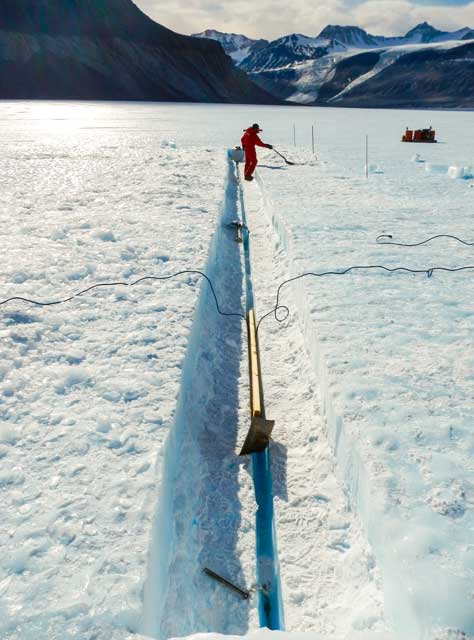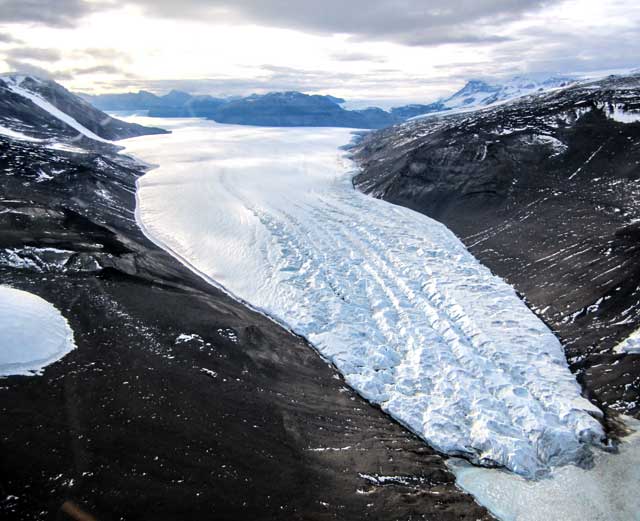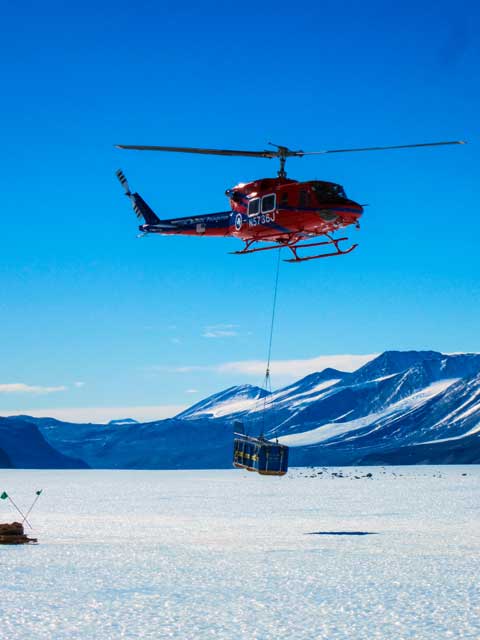
Antarctica conjures many different images depending on the imagination. Ice. Cold. Penguins.
For Sarah Aciego, it's dust.
Those who have visited McMurdo Station during the height of summer in January and February are familiar with the dust devils that swirl through the research town after the snow has melted and the muddy rivers of snowmelt have dried up. However, Ross Island isn't like most of the rest of the continent, more than 99 percent of which is perpetually covered in ice.

But it's exactly that ice where Aciego, an assistant professor in the Department of Earth and Environmental Sciences at the University of Michigan, hunts for microscopic bits of dust that may have landed in Antarctica thousands of years ago from half a world away.
"Dust is really important because it can inform planet dynamics," Aciego said during a presentation about her National Science Foundation-funded project at McMurdo Station.
Dust in the atmosphere can actually alter atmospheric chemistry, as well as change the radiative balance by absorbing or reflecting incoming solar radiation. Dust carrying micronutrients such as iron that falls into the ocean can influence biological activity. A layer of dust on ice or snow can affect albedo, causing the surface to absorb more sunlight.
Today, scientists can use satellites to pinpoint major dust storms and employ computer models to determine where atmospheric winds will deposit material.
"In the past, we can't look and see where it came from. We need some other mechanism for determining where the dust came from and what its pathway was," Aciego explained.
That's where Antarctic ice comes in — a lot of Antarctic ice, from a glacier not far from McMurdo Station in the nearby McMurdo Dry Valleys.
Taylor Glacier is a river of ice that flows from a high point on the East Antarctic Ice Sheet called Taylor Dome. It terminates in Taylor Valley at the shore of the ice-covered Lake Bonney. On the surface of the glacier, about 15 kilometers from its terminus, scientists have discovered a gold mine of ice.
Make that a mine of blue ice thanks to its location in an ablation zone, where there is negative accumulation of snow and ice. In combination with how the ice flows through the valley, researchers have found and mapped ice stratigraphy at the surface that is up to 150,000 years old.

Scientists already know that dust concentrations are much higher during the 100,000-year-long glacial periods that have dominated climate for at least the last million years than compared to the warmer interglacial periods. However, in recent centuries, with industrialization, intensive agricultural practices and climate change, dust production is up by 500 percent, according to Aciego.
"It's huge," she said, though still far less than what occurred during the cold, dry glacial periods. What's not huge is the amount of ancient dust available to Aciego and her team for the isotopic techniques they use to date the dust and determine its composition, which they can use to determine its provenance or source.
In a traditional ice core drilled vertically through an ice sheet, there is about 1 milligram of dust per half-meter of ice from a glacial period, according to Aciego. That's roughly the equivalent of one grain of salt. During warmer interglacial periods, that number drops to 0.01 milligrams per meter-long ice core.
Scientists use ice cores for various studies aside from dust measurements, such as a way to learn about the composition of the Earth's past atmosphere from bubbles of gas trapped in the ice, meaning there is a lot of competition for very limited samples.
"We need more ice," Aciego said.
On Taylor Glacier, near the surface, is a nearly inexhaustible supply of such ice.
"If you want to look at high-resolution changes in dust records, you have to have bigger samples in the horizontal direction," Aciego said.

That's what she and her team did during the 2013-14 summer season, joining another research group on the glacier that was mining ice for paleoclimate studies involving methane. [See related article — Cooking with gas: Scientists extract big ice cores from Taylor Glacier for methane measurements.] Both groups used a specialized drill developed and built by the Ice Drilling Design and Operations (IDDO)group at the University of Wisconsin-Madison to extract large ice cores from just below the surface.
The cores collected by Aciego and her team will eventually be melted to extract micro grains of dust to conduct radiogenic isotope geochemistry analyses on the samples. Radiogenic isotope geochemistry uses techniques to measure radioactive isotopes resulting from the natural decay of elements.
The two principal methods — rubidium-strontium and samarium-neodymium — should help date and identify the provenance of the dust over a time period of 6,000 to 55,000 years ago. That's when researchers believe storm trajectories in the region reversed due to the retreat of the Ross Ice Shelf. The climate system was once dominated by storms from the north rather than from the south as they are today, according to Aciego.
The change in wind trajectories should be reflected in the radiogenic isotopes, concentration, and size distribution of dust particles within the Taylor Glacier ice, she said. In addition, the project may differentiate regional versus global dust sources to the Taylor Glacier and provide a continuous record of southern hemisphere dust during abrupt climate change events.
"This research has potential implications for predicting the climate shifts in circumpolar coastal regions that have been experiencing or will experience a decrease in ice shelf extent," Aciego said.
